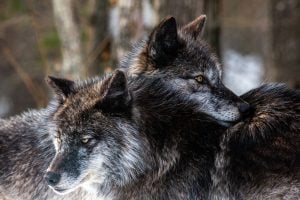
Wildlife
The big bad wolf?
Exploring our love-hate relationship with the wolf
- 2255 words
- 10 minutes
Wildlife
Wolves! Shape-shifters in a Changing World unpacks the complex social lives of wolves through culture and science alongside stunning images by photographer Michelle Valberg

For thousands of years, humans have regarded wolves as one of the animal kingdom’s most elusive mammals. Famous for their intricate social lives, adaptability and spine-tingling howls, these large canines can be found across the northern hemisphere and have proven themselves as an ecological wonder. Feared by some but admired by many, wolves are fierce predators with remarkable intelligence that can thrive in many different environments as a result of their high resilience.
Wolves! Shape-shifters in a Changing World, is the new exhibition at the Canadian Museum of Nature that explores the evolution and adaptation of these fascinating animals through cultural stories, scientific research, specimens and more. Also included in the exhibition are large-scale photographs by renowned Canadian photographer Michelle Valberg that truly bring the exhibition to life.
From pop culture items to skeletal remains, this exhibit captivates visitors from start to finish, offering a new lens on our relationship with one of the world’s most popular animals. Here are five things visitors can expect from a visit to the exhibition.

The exhibit is anchored and inspired by the work of Canadian Geographic’s own photographer-in-residence and Fellow, Michelle Valberg. Taken from her expeditions viewing coastal wolves on Vancouver Island and Yellowstone National Park in the United States, a series of large, colourful images of the elusive wolves of the West can be seen on display throughout the exhibit.
Sitting patiently for hours and sometimes even days on end, Valberg hid in blinds to capture the perfect shots of the wolves on their own and in their pack. And her efforts were worth the wait as the outcome is stunning images with the wolves’ eyes piercing right into you as their fur jumps out of the frame.
Valberg made the biggest connection with “Wink”, one of the wolves she was able to photograph the most.
“It was a thrill of a lifetime,” said Valberg while glancing at her work on the walls. “I got there, getting stuck in mud and slipping on rocks and trails but then to be able to spend that time and watch [Wink’s] behaviour and watch us lock our eyes, I really feel a connection to him.”
Wolves have “shapeshifted” and adapted to the changing climate for millions of years, making them the most widely distributed large land mammal. Wolf skulls are massive, especially when compared to the skull of a modern-day chihuahua. In this section of the exhibit, visitors can see the evolution of wolves all the way to the domesticated dog, with a display of Canada’s current wolf-descended pets.


For visitors interested in the science behind wolves, displays of wolf skulls can confirm just how impressive the jaws and teeth of canines really are.
Here, the exhibit offers a behind-the-scenes look at the tools of some of the museum’s research scientists. This includes the work of Dr. Danielle Fraser who tries to solve the mysteries behind these elusive predators.
“I think [wolves] sort of have this beauty and mystique that inspires everybody on my end in a scientific sense,” said Fraser with a smile. “I find them fascinating because they’re these organisms that change the entire landscape in which they live.”
Wolves are impressive predators in our ecosystems, but they are also a mammal we have made particular connections with. In this portion of the exhibition, artworks by Inuit and First Nations artists are complemented by the wolf stories Indigenous Peoples have shared for hundreds of years. Following this, a collection of pop-culture media showcases the Western fascination with wolves through artefacts that include a poster for the movie Teen Wolf and a vintage copy of Little Red Riding Hood.



Visitors can also get the chance to test their canine knowledge in one of the several interactive displays, including the opportunity to identify real mammal skulls.
The exhibit also offers visitors the chance to make various wolf paw prints out of clay. These activities, among others, will be available for the first two weeks of the exhibition (March 4 to 19) – the perfect place to visit for the Ontario and Quebec school breaks. From March 6 to 13, visitors can also stop by to meet representatives from the Canadian Guide Dogs for the Blind, and their canine assistants.
Wolves! Shape-shifters in a Changing World is included with general admission to the Canadian Museum of Nature and will be on display until March 2024.
Are you passionate about Canadian geography?
You can support Canadian Geographic in 3 ways:

Wildlife
Exploring our love-hate relationship with the wolf

Wildlife
Wildlife photographers on the thrill of the chase — and the importance of setting ethical guidelines

Wildlife
An estimated annual $175-billion business, the illegal trade in wildlife is the world’s fourth-largest criminal enterprise. It stands to radically alter the animal kingdom.

Wildlife
Canadian Geographic is pleased to honour 14 photographers for their outstanding images of Canadian wildlife